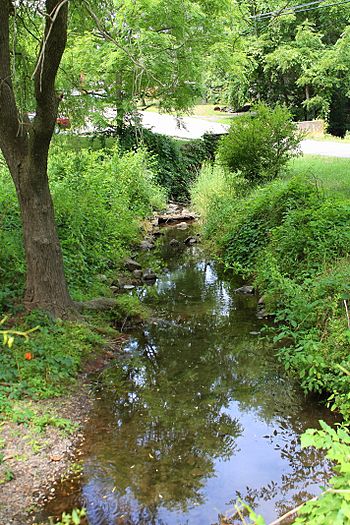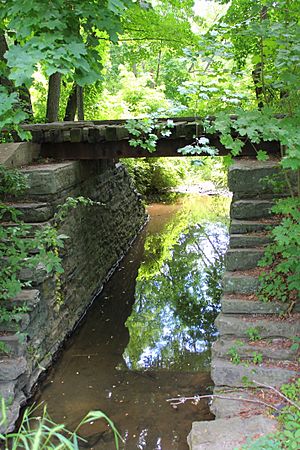Swale Brook facts for kids
Quick facts for kids Swale Brook |
|
|---|---|

Swale Brook in Tunkhannock
|
|
| Physical characteristics | |
| Main source | Cruver Pond in Tunkhannock Township, Wyoming County, Pennsylvania between 1,040 and 1,060 feet (317 and 323 m) |
| River mouth | Tunkhannock Creek in Tunkhannock, Wyoming County, Pennsylvania 607 ft (185 m) 41°32′15″N 75°56′10″W / 41.53745°N 75.93600°W |
| Length | 2.9 mi (4.7 km) |
| Basin features | |
| Progression | Tunkhannock Creek → Susquehanna River → Chesapeake Bay |
| Basin size | 4.01 sq mi (10.4 km2) |
| Tributaries |
|
Swale Brook is a small stream, also called a tributary, that flows into Tunkhannock Creek in Wyoming County, Pennsylvania. It's about 2.9 miles (4.7 km) long. The stream flows through Tunkhannock Township and the town of Tunkhannock.
The area around Swale Brook is home to many different kinds of fish. The stream is known for its clean, cold water and is a great place for fish to live and migrate.
Contents
The Path of Swale Brook
Swale Brook starts in a place called Cruver Pond in Tunkhannock Township. It flows mostly towards the south-southwest for a short distance. Along the way, it gets water from a smaller stream that joins it from the right side.
After flowing for a bit, the stream turns towards the east-southeast for more than a mile. It then enters the town of Tunkhannock. Here, another small stream joins it from the left side. Swale Brook then crosses Pennsylvania Route 29 and turns towards the south-southeast. A little further downstream, it crosses US Route 6. Soon after, Swale Brook meets and joins Tunkhannock Creek.
Swale Brook joins Tunkhannock Creek about 0.64 miles (1.03 km) before Tunkhannock Creek reaches its own end.
Swale Brook's Water
Swale Brook is considered a very healthy stream. This means its water is clean and safe for plants and animals. People have described the water in Swale Brook as "pure, cold water." This is good news for the fish and other creatures that live there.
What the Land is Like
The land around the mouth of Swale Brook is about 607 feet (185 m) above sea level. Where the stream begins, its source, the land is higher, between 1,040 and 1,060 feet (317 and 323 m) above sea level. Swale Brook is a small stream, so small that you could easily step across it in many places.
The ground near the stream is made up of different types of soil and rock. Near the lower and middle parts of the stream, you can find alluvium (soil left by flowing water), old river deposits, and materials left by glaciers from the last Ice Age. Higher up, near where the stream starts, the ground is mostly made of a type of till (rock and soil left by glaciers).
The Area Around the Stream
The entire area that drains water into Swale Brook, called its watershed, covers about 4.01 square miles (10.4 km2). The stream is located entirely within the Tunkhannock area on maps made by the United States Geological Survey. Its mouth is right in the town of Tunkhannock.
Cruver Pond is a small pond located at the very beginning of Swale Brook. There are several roads that cross over the stream. Also, a railroad bridge crosses over Swale Brook.
A Look at History
Swale Brook was officially named and added to the Geographic Names Information System on August 2, 1979. It has also been known by another name, Quaker Swamp Brook. This older name was mentioned in a book from 1883 about the geology of the Susquehanna River region.
Long ago, in the mid-1800s, a tannery (a place that makes leather) was built on Swale Brook. By 1888, a mill was built on the stream in Tunkhannock. This mill used the stream's water power to make wooden butter pails, tubs, shingles, and even cider. In 1902, wood from a covered bridge that was damaged by a flood was brought to this mill to be processed.
An electric power plant that used steam used to operate near Swale Brook until 1903. Around 1906, a canning factory near the stream closed down. Then, the Pennsylvania Witch Hazel Company opened in the same spot. Swale Brook has experienced flooding in the past, including during Hurricane Agnes in 1972 and again in 2011.
Amazing Stream Life
The area around Swale Brook is special because it's a "Coldwater Fishery" and a "Migratory Fishery." This means it's a great place for fish that like cold water and for fish that travel to different places to lay their eggs.
Swale Brook has a very high level of fish diversity, meaning many different kinds of fish live there. It's been described as "packed with fish diversity." At least ten different fish species have been seen in the stream. These include fish like eastern blacknose dace, common shiners, yellow bullheads, and the rare brook stickleback.
The land right next to Swale Brook, called the riparian buffer, has a lot of plants and trees in some areas. This dense plant life helps keep the stream healthy.


